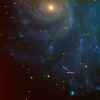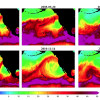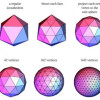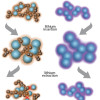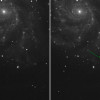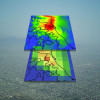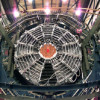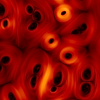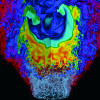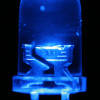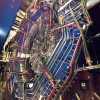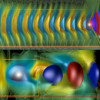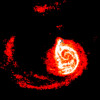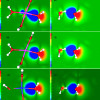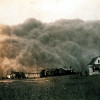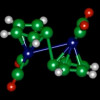Science News
Closest Type Ia Supernova in Decades Solves a Cosmic Mystery
Even as the "supernova of a generation" came into view in backyards across the northern hemisphere last August, physicists and astronomers who had caught its earliest moments were developing a surprising and much clearer picture of what happens during a titanic Type Ia explosion. Now they have announced the closest, most detailed look ever at one of the universe’s brightest “standard candles,” the celestial mileposts that led to the discovery of dark energy. Read More »
A Better Way to ID Extreme Weather Events in Climate Models
A team of researchers that includes Berkeley Lab scientists are using state-of-the-art methods in data mining and high-performance computing to quantify extreme weather phenomena in the very large datasets generated by today’s climate models. Their work will help scientists predict how climate change impact the frequency of extreme weather events. Read More »
Supercomputers Take a Cue From Microwave Ovens
To build the break-through supercomputers that climate researchers need to model clouds, scientists are taking a cue from consumer electronics where everything from chips to batteries to software is optimized to the device’s application. Read More »
Turning Grass into Gas for Less
Recent computer simulations carried out at the National Energy Research Scientific Computing Center (NERSC) could help scientists in their quest to make biofuels from grasses and other inedible plants. Read More »
A Better Lithium-ion Battery on the Way
Lithium-ion batteries are everywhere, in smart phones, laptops, an array of other consumer electronics, and the newest electric cars. Good as they are, they could be much better, especially when it comes to lowering the cost and extending the range of electric cars. To do that, batteries need to store a lot more energy. A team of scientists at the U.S. Department of Energy’s Lawrence Berkeley National Laboratory (Berkeley Lab) has designed a new kind of anode — a critical… Read More »
Supernova Caught in the Act
A supernova discovered yesterday is closer to Earth—approximately 21 million light-years away—than any other of its kind in a generation. Astronomers believe they caught the supernova within hours of its explosion, a rare feat made possible by a specialized survey telescope and state-of-the-art computational tools.The discovery of such a supernova so early and so close has energized the astronomical community as they are scrambling to observe it with as many telescopes as possible,… Read More »
Small Particles, Big Impact
High-resolution simulation for Mexico City (top), shows a more detailed and accurate picture of aerosol pollution compared to representations of a global climate model (bottom). The deep red to light green colors represent concentrations of aerosol pollution with red being highest, light green lowest. Using systems at the National Energy Research Scientific Computing Center (NERSC), atmospheric scientists at the Pacific Northwest National Laboratory (PNNL) have found that small scale effects of… Read More »
Magellan Tackles Mysterious Proton Spin
The STAR experiment's detector records the decay of subatomic smash-ups to uncover how the fundamental building blocks of the universe work. What makes a proton spin? That is one of the biggest mysteries in physics. Although researchers do not fully understand the underlying physics of this phenomenon, they do know that it contributes to the stability of the universe, magnetic interactions, and are a vital component of technologies like Magnetic Resonance Imaging (MRI) machines that are used… Read More »
At Solar System's Edge, There be...Bubbles?
This animated computer simulation shows how magnetic bubbles form at the edge of our solar system. It was created on NERSC's "Franklin" supercomputer using 8,192 processor cores simultaneously running for 20 hours. (Credit: James F. Drake) NASA's Voyager probes have reached the end of our solar system where they've found neither giants nor dragons, but something nearly as surprising—a turbulent froth of magnetic bubbles. Using new computer models to analyze Voyager data, scientists computing… Read More »
Petaflops Power to NERSC
The National Energy Research Scientific Computing Center (NERSC) recently marked a major milestone, putting its first petascale supercomputer into the hands of its 4,000 scientific users. The flagship Cray XE6 system is called “Hopper” in honor of American computer scientist Grace Murray Hopper; it is capable of more than one quadrillion floating point operations per second, or one petaflops, and is currently the second most powerful supercomputer in the United States, according to the TOP500 list. Read More »
NERSC Systems Help Develop Next-Generation Combustion Equipment
Robert Cheng demonstrates his low swirl burner in the lab. The housing remains cool to the touch, as shown here. Combustion – the complex chemical process of burning fuels – is a huge driver behind the American economy and standard of living, producing more than 83 percent of our nation’s energy. In addition to fueling power plants, combustion also drives aircraft, ships, locomotives, and trucks and cars (even hybrids). At home, we rely on combustion for heating systems, water heaters,… Read More »
Proton Dripping Tests a Basic Force of Nature
Despite its prevalence in nature, researchers are still searching for the precise laws that govern the strong force--the essential "glue" that holds atomic nuclei together to form atoms. However, the recent discovery of an extremely exotic, short-lived nucleus called fluorine-14 in laboratory experiments may indicate that scientists are gaining a better grasp of these rules.
Read More »
LED Lighting Comes out of the Dark
New findings from simulations carried out at the National Energy Research Scientific Computing Center (NERSC) have unearthed the cause of a problem that limits the use of ultra-efficient, light-emitting diodes in general lighting, researchers say. Read More »
Heaviest Antimatter Particle Detected with NERSC Help
Eighteen examples of the heaviest antiparticle ever found, the nucleus of antihelium-4, have been made in the STAR experiment at RHIC, the Relativistic Heavy Ion Collider at the U.S. Department of Energy’s Brookhaven National Laboratory. The finding wasn’t unexpected, but it is a milestone for scientists exploring a fundamental puzzle of physics: Why is there any matter at all? Read More »
Boosting the Next Wave of Accelerators
Generating computer models of 'tabletop accelerators' has proven difficult, slow, and costly. To solve this problem, a team of scientists computing at the National Energy Research Scientific Computing Center (NERSC) has perfected a new method that generates models anywhere from 10,000 to a million times faster than before.
Read More »
'Dark' Milky Way Satellite Galaxy Uncovered
Sukanya Chakrabarti has developed a mathematical method uncover “dark” satellite galaxies. When she applied this method to our own Milky Way, Chakrabarti discovered a faint satellite might be lurking on the opposite side of the galaxy from Earth, approximately 300,000 light-years from the galactic center. Read More »
Cyclones Linked to Pliocene Warming
Scientists searching for clues to Earth’s future climate are turning to its dim past, the Pliocene epoch. Using computer simulations, researchers are unraveling a mystery that has bedeviled climatologists for years: Why was the Pliocene – under conditions similar to today – so much hotter? Recent work suggests that tropical cyclones (also called hurricanes or typhoons) may have played a crucial role. Read More »
Modeling the Bonds of Iron and Water
Using supercomputers at the Department of Energy's National Energy Research Scientific Computing Center (NERSC), scientists have successfully modeled the atomic interactions between a high spin ferric iron ion and 64 water molecules for the first time. Researchers say this unprecedentedly accurate model will offer valuable insights into key reactions involved in carbon sequestration and other environmental remediation projects. Read More »
A Goldilocks Catalyst
Carbon dioxide (CO2) emissions from fossil fuel combustion are major contributors to global warming. Since CO2 comes from fuel, why can't we recycle it back into fuel rather than releasing it into the atmosphere? Read More »
Clearer Picture of Carbon Sequestration
Berkeley Lab scientists are using computer simulations run at NERSC to help evaluate one method for keeping carbon dioxide emitted by fossil fueled power plants out of the atmosphere: Geologic sequestration in salty water reservoirs deep underground. Researchers have created the most detailed models yet of the mixing processes that occur at the interface of sequestered carbon dioxide (CO 2) and brine in geologic sequestration projects.These simulations—including the first three-dimensional ones—will help scientists better predict the success of this kind of project. Read More »
Climate Time-Machine
An international team of climatologists have created a comprehensive reanalysis of all global weather events from 1871 to the present day with help from NERSC. Over the last four years, the project's leader, Gil Compo, has put to use over 20 million processing hours at NERSC to help make it happen. Read More »
Rechargeable Heat Battery's Secret Revealed
Researchers computing at NERSC have shown that a fulvalene diruthenium molecule undergoes a structural transformation when it absorbs sunlight, putting the molecule into a higher-energy or charged state where it can remain stable indefinitely. Then, triggered by a small addition of heat or a catalyst, it snaps back to its original shape, releasing heat in the process. Read More »






